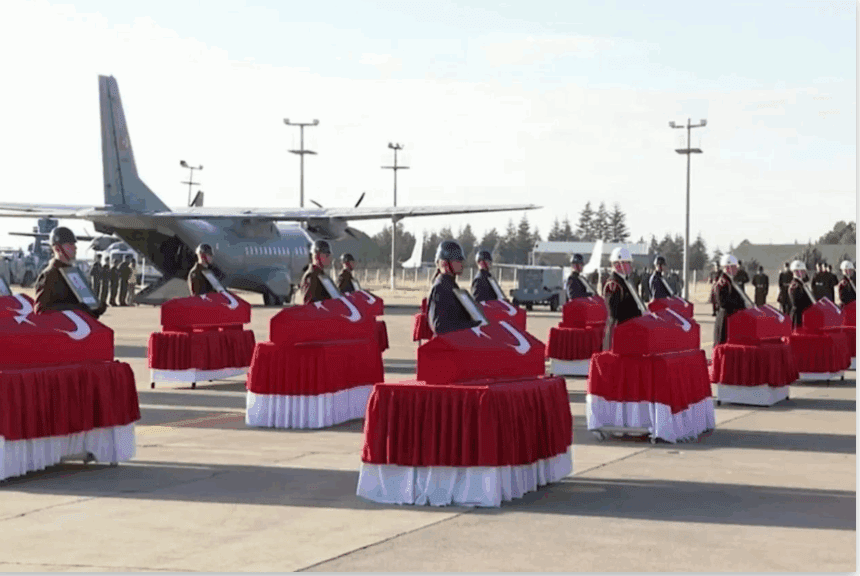Turkish Defense Minister Yaşar Güler has said it will take a minimum of two months to decode the black boxes and reach initial conclusions about last week’s fatal crash of a C-130 military cargo plane on the Azerbaijan–Georgia border, which killed all 20 people on board.
Speaking to reporters in Ankara after a Cabinet meeting on Monday, Güler said the flight data recorder and cockpit voice recorder, recovered from the wreckage a day after the crash, have been brought to Turkey and are now being examined by Turkish Aerospace Industries (TAI). He cautioned that the technical work is complex and time-consuming, adding that “the process of decoding the devices and reaching initial findings will take at least two months.”
The C-130 Hercules transport aircraft went down on November 11 in Georgia’s Kakheti region, near the town of Sighnaghi, shortly after crossing the border from Azerbaijan. It had taken off from Ganja International Airport in western Azerbaijan and was heading back to Turkey when it broke apart in mid-air and crashed, scattering debris across fields and hillsides.
Turkey’s defense ministry confirmed that all 20 occupants — the flight crew and military personnel — were killed, making it the country’s deadliest military aviation disaster since 2020. The passengers included a team of F-16 maintenance specialists and support staff who had been in Azerbaijan for Victory Day celebrations and a military parade in Baku on November 8, marking Azerbaijan’s 2020 victory in the Nagorno-Karabakh war.
Eyewitness video filmed from the ground and widely shared by Azerbaijani and Georgian media shows the aircraft spinning as it falls, with large sections of the airframe breaking away during its descent. One clip appears to show the central fuselage and wings spiraling down while other pieces of debris separate and trail behind, consistent with an in-flight breakup rather than a controlled descent.
Güler said early technical assessments — which he stressed were not final — suggest the tail section may have detached before the rest of the plane broke into three main parts. “These details will be clarified through the black boxes. The recorders are currently being examined by Turkish Aerospace Industries,” he noted.
The minister also moved to reassure the public about the C-130 fleet’s safety record, pointing out that Turkey has operated Hercules transports since 1957. Apart from an engine fire in 1999 in which the crew managed to land safely, Güler said the type has generally proven reliable.
Even so, Ankara grounded all 18 C-130 aircraft in the Turkish Armed Forces one day after the accident as a precaution, pending detailed inspections. The decision effectively halts one of the air force’s main tactical airlift capabilities while investigators work to determine whether age-related structural issues, maintenance shortcomings or other technical factors played a role.
The aircraft involved in the crash was a 57-year-old C-130EM Hercules, originally delivered to the Royal Saudi Air Force in the late 1960s and later acquired second-hand by Turkey. It was purchased from Saudi Arabia in 2012 and added to the Turkish Air Force inventory after upgrades and overhaul. According to officials, the plane underwent a modernization program and reentered service in 2022; it passed its most recent maintenance check in mid-October, roughly a month before the crash.
The cargo manifest indicates the aircraft was transporting personnel, spare parts and maintenance equipment for F-16 fighter jets and was not carrying ammunition or weapons. Both Turkish and Azerbaijani sources have emphasized that only technical equipment and supplies were on board.
Images from the crash site show wreckage strewn across a wide area of farmland near the Azerbaijan–Georgia border, with investigators from Turkey, Georgia and Azerbaijan combing the debris field. A Turkish military investigation team and Georgian authorities launched a joint probe soon after the crash, and a separate inquiry has been opened in Azerbaijan under statutes covering violations of flight safety rules leading to fatalities.
The dramatic nature of the in-flight breakup and the absence of any distress call have sparked intense discussion on Turkish and regional social media, where some users have floated theories ranging from sabotage to a missile strike. A columnist for the pro-government daily Hürriyet wrote that investigators are examining all possibilities, including whether the plane could have been shot down, reflecting broader anxieties about security in the South Caucasus.
However, other media citing technical sources in Azerbaijan reported that initial visual inspections of the wreckage found no signs of an external impact or onboard explosion, and that early working hypotheses focus on a possible structural failure — potentially linked to corrosion — or a shift in cargo that may have destabilized the aircraft. Turkish officials, including Güler, have repeatedly said it is “too early” to attribute the crash to any specific cause and insist that definitive answers must wait for the black box data and detailed forensic analysis.
The crash has reverberated deeply inside Turkey’s armed forces. A large funeral ceremony was held at a military airbase in Ankara on November 14, where the coffins of the 20 personnel, draped in Turkish flags, were lined up on the tarmac as families, senior officials and fellow soldiers paid their respects. The bodies have since been transported to the victims’ hometowns across the country for burial.
Turkey’s allies and regional partners, including Azerbaijan and Georgia, sent condolences, as did NATO Secretary General Mark Rutte and senior Western officials. Lockheed Martin, the U.S. manufacturer of the C-130, has said it will assist the investigation if requested.
The accident comes at a time when Ankara is already seeking to renew and modernize its transport fleet. Just weeks before the crash, Turkey finalized a deal with Britain to acquire 12 additional C-130s for upgrade and future service, part of a broader effort to bolster airlift capacity amid growing regional commitments and operations.
For now, the focus in Ankara remains on the painstaking work of reconstructing what happened in the final minutes of the flight. With the black boxes in a secure laboratory and the wreckage under detailed examination, officials say the next few months will be crucial in determining whether the tragedy was the result of age, technical failure or some other factor — and in deciding when, and under what conditions, Turkey’s grounded C-130 fleet can safely return to the skies.



